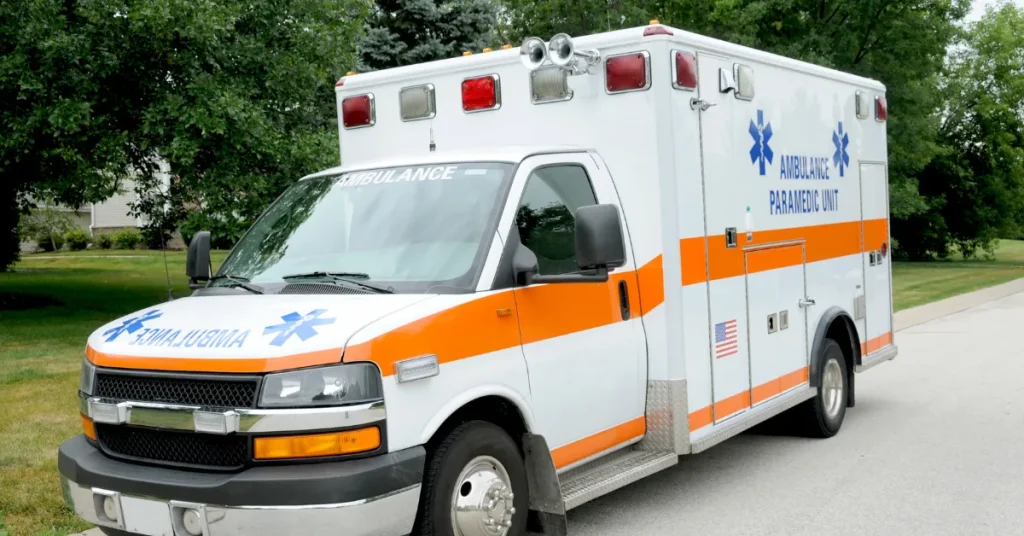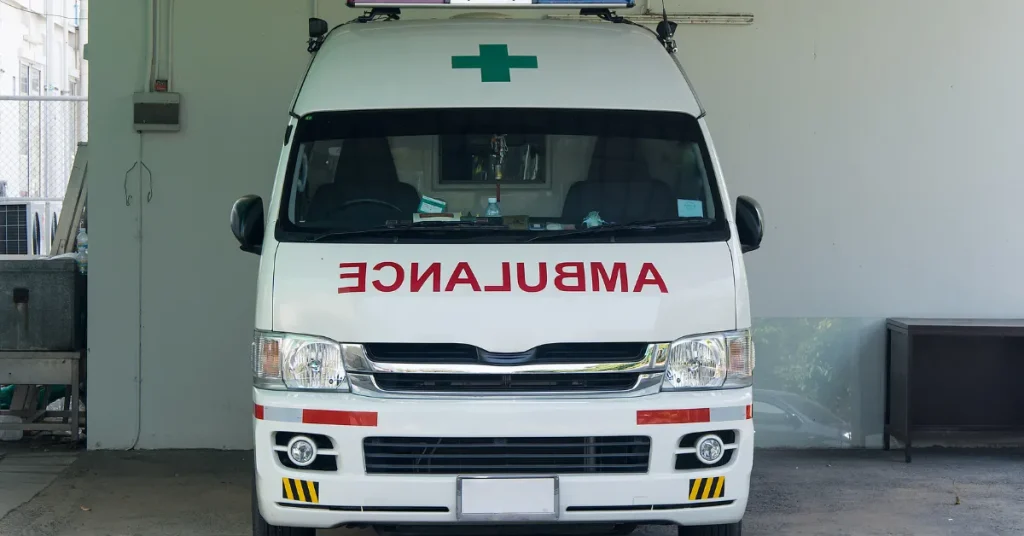An average ambulance has a width of around 95 inches or 2.4 meters. This width allows for the necessary space to accommodate patients and medical equipment while navigating through traffic.
Ambulances are vital vehicles equipped with lifesaving equipment and designed for the rapid transport of patients. The width provides enough interior room for paramedics to move efficiently and care for patients during transit.
Width specifications can vary by country and ambulance type; Type I, II, and III each possesses different dimensional features to cater to various medical situations.
Crucially, the width of an ambulance must balance the need for interior space with the ability to maneuver in tight urban areas, hence the relatively standard size across models.
With urban infrastructure and road design in mind, ambulance width ensures both accessibility to patients in need and compatibility with city traffic systems.
Ensuring clear passageways for these emergency vehicles is paramount, which is why understanding their dimensions is important for both city planners and drivers alike.

Ambulance Dimensions: More Than Just Width
Welcome to our deep dive into the world of medical transportation: the ambulance. Often, we think width is the only crucial factor.
Yet, an ambulance’s size involves much more. Let’s explore the dimensions that enable these life-saving vehicles to perform at their best.
Why Size Matters
Size plays a key role in an ambulance’s functionality. A well-sized ambulance ensures:
- Accessibility in tight city lanes or crowded streets.
- Comfort and safety for patients and medical personnel.
- Capability to carry essential medical equipment.
- Efficient maneuverability and speed in emergencies.
Typical Exterior Measurements
Ambulances come in various shapes and sizes. However, some common exterior measurements include:
| Type | Length | Width | Height |
| Type I | 260 to 290 inches | 95 inches | 90 to 95 inches |
| Type II | 240 inches | 90 inches | 75 inches |
| Type III | 250 to 290 inches | 95 inches | 90 to 95 inches |
These figures highlight the overall size of an ambulance, which may vary by model and manufacturer.
Inside An Ambulance: Spatial Dynamics
Peek inside an ambulance and it’s clear, every inch counts. Understanding the spatial dynamics reveals how ambulances are more than vehicles; they are high-tech, mobile medical rooms.
The space must be strategic, catering for patient care and essential medical equipment storage. Let’s delve into the precise dimensions and organization inside these life-saving transports.
Patient Care Area Dimensions
The patient care area, the heart of the ambulance, is where medical personnel attend to patients. It’s designed to maximize care efficiency. Let’s break down the size.
| Area | Approximate Dimensions |
| Length | 8 to 14 feet |
| Width | 6 to 8 feet |
| Height | 5 to 6 feet |
These dimensions ensure enough room for one or more medical staff to work around a patient on a stretcher.
Contributing to these space requirements are critical features, including an adjustable stretcher, bench seating, and built-in cabinets. All allow for immediate response during transport.
Equipment And Storage Space
Every tool, device, and supply has a specific place inside an ambulance. The goal is swift accessibility and optimal space management. Here’s what to expect:
- Secured Cabinets: Store medications and small equipment.
- Pre-built Shelves: Accommodate larger devices and first aid supplies.
- Safe Restraints: Ensure equipment stability during travel.
- Hangar Area: Specifically for IV bags and oxygen tanks.
The design of these spaces considers the urgency of medical situations. Staff must reach any item in seconds. Thus, the arrangement is intuitive and standardized, allowing paramedics to work efficiently and effectively.
Types Of Ambulances: Varied Sizes For Different Needs

Ambulances come in several types and sizes. Each serves a unique purpose. Some are for basic transport while others handle advanced emergencies. In this post, we’ll explore the Type I, II, III, and IV classifications and their dimensions.
Type I, Ii, Iii, And Iv Classifications
Type I ambulances are built on truck-like chassis. This means they often have more room. Type II models are based on passenger or cargo vans.
They are more compact. Type III ambulances are similar to Type I but have a different cab design. Type IV ambulances are for quick response and are the smallest.
Comparing Dimensions By Ambulance Type
| Type | Width | Height | Length |
| Type I | 95 inches | 108-130 inches | 160-190 inches |
| Type II | 89 inches | 72-90 inches | 150-175 inches |
| Type III | 95 inches | 100-136 inches | 170-193 inches |
| Type IV | 70 inches | 64-74 inches | 160-170 inches |
Width, height, and length vary by ambulance type. The above table shows their general dimensions. Remember, these numbers can change based on the manufacturer and specific build.
Evolution Of Ambulance Design
The way ambulances look and work has changed a lot over time. From horse-drawn carts to advanced mobile medical units, ambulances have evolved to better serve patients in need.
With careful design focused on width, equipment, and technology, the modern ambulance is a hallmark of emergency services worldwide.
Historical Perspectives
In the beginning, ambulances were simple. Horse-drawn vehicles carried the injured and sick. These carriages were narrow and long, built to fit the roads of old cities. The width was often no more than two meters.
As cars became popular, motor-powered ambulances took over. Their designs varied, but the focus remained on access to patients and healthcare essentials.
- Horse-drawn ambulances – 2 meters wide approx.
- Early motor ambulances – slightly wider for more space.
Modern Advancements And Requirements
Today, ambulances must meet many needs. Designers must balance space for care with the need for speed and maneuverability.
In most countries, the standard width of an ambulance is around 2.5 meters. This size helps ambulances move through traffic and park in tight spots.
| Type of Ambulance | Average Width |
| ALS Ambulances | 2.5 meters |
| BLS Ambulances | 2.5 meters |
| Specialty Ambulances | Varies with design |
New rules say ambulances must have certain tools. They must have spaces for medics to work and spots for patients to be safe.
Many now include tech like GPS and systems that send patient data quickly to the hospital. Every change made is to make sure patients get the help they need fast.
- Standard width – 2.5 meters for fitting urban environments.
- Regulations demand space for medical equipment and patient care.
- Integrated technology for better on-road care.
The journey from the past to now shows us how caring for people drives innovation. Each advance in design makes ambulances better helpers in emergencies.
Knowing how wide an ambulance is helps us appreciate the balance between a vehicle’s size and its lifesaving functions.
Navigating Urban Landscapes: Ambulance Width Constraints

Ambulances need to cut through busy streets quick and safe. When they rush to save lives, size matters. Navigating Urban Landscapes: Ambulance Width Constraints is not just about fitting through narrow spaces.
It’s about speed, agility, and safety. This section dives deep into the width of ambulances and how they maneuver through packed cities.
Challenges And Solutions
In urban sprawls, ambulances face tight turns and parked cars. Standard ambulances are around 95 inches wide. But city lanes can be unpredictable. Every second counts during an emergency.
- Wider mirrors can clip on tight corners.
- Busy streets slow down response times.
Solutions include:
- Using foldable mirrors to reduce width.
- Deploying smaller ambulances in dense areas.
- Implementing clear-lane policies during rush hour.
Regulatory Considerations
Each country has rules for ambulance size. These rules affect how ambulances move in cities. Providers must balance legal limits with the need for fast aid.
| Country | Max Width (inches) |
| USA | 96 |
| UK | 98.4 |
Ambulances must follow these limits and still carry all life-saving tools. It’s a tough job, but smart design and city cooperation make it possible.
Custom Ambulances: Catering To Specific Requirements
Some emergencies need special kinds of ambulances. Doctors and paramedics must have tools to help everyone quickly. That’s why some ambulances get made to meet these special needs.
Big cities or small towns can have different types of these custom ambulances. Let’s dive into the world of specialized designs and real stories of these unique vehicles.
Specialized Designs
Special ambulances come in various sizes. Factories build these to do special jobs. Each one is different, just like each emergency is unique.
- Broad doors for easy movement.
- Extra space for big medical tools.
- Strong electricity to run all machines.
Features like suspended cabinets and advanced communication tools are key. They make sure paramedics can do their best work. It’s all about making sure each ambulance fits the job it will do.
Case Studies
Stories of real ambulances show how custom designs truly help. They show creative solutions to tough problems.
- City Center Response Vehicle:
- Narrow and fast for busy streets.
- Has lifesaving tools for heart problems.
- Rural Area Ambulance:
- Big and strong tires for rough paths.
- Wider to carry more gear over long distances.
These examples show tailored solutions for unique challenges in saving lives.
FAQs About How Wide Is An Ambulance
What Are The Specs Of An Ambulance?
Ambulance specs typically include medical equipment, a siren, flashing lights, radio communication, and patient transport capacity. Capacity usually ranges from 2 to 10 passengers. Dimensions and weight vary by model, adhering to local regulations.
What Size Is A Medium Duty Ambulance?
A medium-duty ambulance typically has dimensions around 24-26 feet in length, 95 inches in width, and 9-10 feet in height.
What Are The Dimensions Of An Ambulance Parking Space?
An ambulance parking space typically requires dimensions of about 10 feet wide by 20 feet long to accommodate standard ambulances.
What Is The Average Weight Of An Ambulance?
The average weight of an ambulance ranges from 10,000 to 14,000 pounds, depending on the vehicle’s size and equipment.
Conclusion
Understanding ambulance dimensions is crucial for various reasons, from navigating traffic to hospital design. Typically, ambulances range from 72 to 95 inches in width.
Being aware of these measurements ensures efficient emergency services and preparedness in infrastructural planning. Always check local regulations for precise dimensions applicable to your area.
Resources:
1. https://www.nist.gov/blogs/taking-measure/safety-standards-ambulances-stat
